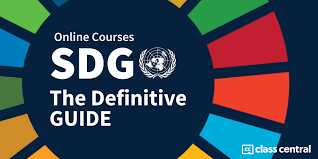Introduction:
In a world marked by intricate challenges and global interconnectedness, the United Nations' Sustainable Development Goals (SDGs) emerge as a comprehensive framework for steering humanity towards a more sustainable and equitable future. Envisioned as a universal call to action, the SDGs encompass 17 goals addressing a spectrum of issues from poverty to climate change. This blog aims to delve into the significance of the SDG, their interconnected nature, and the imperative for collective effort to turn these aspirations into reality.
Understanding the SDGs:
Adopted in 2015 by all 193 member states of the United Nations, the SDGs provide a holistic blueprint for addressing pressing global issues. Ranging from ending poverty to promoting clean energy and gender equality, these goals are interconnected, recognizing that sustainable development must address economic, social, and environmental dimensions simultaneously.
No Poverty:
The first goal, "No Poverty," sets the tone for the entire framework, emphasizing the need to eradicate poverty in all its forms. It encompasses not only income poverty but also considers access to education, healthcare, and basic necessities. Achieving this goal requires inclusive economic growth, social protection systems, and targeted efforts to uplift the most vulnerable.
Quality Education:
The fourth goal, "Quality Education," recognizes education as a catalyst for sustainable development. Ensuring inclusive and equitable education for all is not just an essential human right but a cornerstone for breaking the cycle of poverty and fostering informed, empowered communities.
Gender Equality:
"Gender Equality," the fifth goal, is a commitment to breaking down societal barriers based on gender. Beyond being a matter of human rights, gender equality is acknowledged as a driver for economic growth and social development. Empowering women and ensuring equal opportunities for all genders are essential components of this goal.
Climate Action:
The thirteenth goal, "Climate Action," responds to the escalating challenges posed by climate change. From reducing greenhouse gas emissions to building resilience against climate impacts, this goal underscores the urgent need for global cooperation to preserve the planet for present and future generations.
Impact on Global Health:
Goal 3, "Good Health and Well-being," acknowledges the intrinsic link between health and sustainable development. Accessible healthcare, disease prevention, and maternal and child health are integral components. The ongoing global health challenges, exemplified by the COVID-19 pandemic, emphasize the critical importance of Goal 3.
Economic Transformation and Decent Work:
"Decent Work and Economic Growth" (Goal 8) is a call for sustainable economic development that prioritizes job creation, fair labor practices, and entrepreneurship. This goal aims to foster an environment where economic growth benefits everyone, reducing inequalities and promoting social justice.
Technology and Innovation for Sustainable Development:
Goal 9, "Industry, Innovation, and Infrastructure," recognizes the transformative role of technology. It advocates for inclusive and sustainable industrialization, highlighting the importance of innovation in driving progress across various sectors.
Global Partnerships:
Goal 17, "Partnerships for the Goals," underscores the collaborative nature of the SDGs. Achieving these ambitious goals requires partnerships between governments, businesses, and civil society. By fostering collaboration, sharing knowledge, and mobilizing resources, Goal 17 is pivotal in ensuring the success of the entire framework.
Challenges and Opportunities:
While the SDGs provide a comprehensive roadmap, their implementation faces challenges. Insufficient funding, political will, and the intricate interconnectedness of the goals pose hurdles. However, within these challenges lie opportunities for innovation, collaboration, and positive change. The SDGs present a chance to rethink development strategies, emphasizing sustainability, equality, and inclusivity.
Conclusion:
The Sustainable Development Goals serve as a compass, guiding us towards a future where prosperity is shared, and the planet thrives. Achieving these goals demands a collective commitment to transformative action at local, national, and global levels. Embracing the principles of sustainability, equality, and inclusivity is crucial for building a world that is resilient, just, and environmentally responsible. The journey towards sustainable development is ongoing, and our dedication to the SDGs will shape the legacy we leave for future generations. Let us stand united in the pursuit of a better, more sustainable world.
